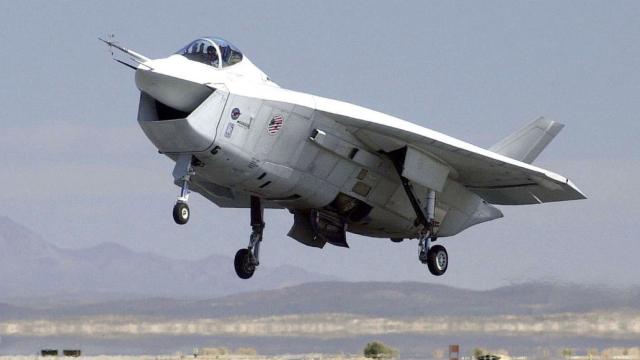The mid-1990s found the US military in need of a low-cost, supersonic stealth fighter jet that all three armed services branches could field. Easy, right? The subsequent — and highly contentious — design competition between Boeing and Lockheed saw the winner take home a $US200 billion defence contract, which in turn became the debacle we know as the F-35. But what about the plane we could have had instead?
The Joint Strike Fighter (JSF) program began in 1996, with the goal of producing a low-cost, multi-role tactical aircraft for the US military and its allies. To that end, it awarded four-year design contracts to both Boeing and Lockheed Martin on the grounds they produce concept demonstration aircraft, more commonly known as technology demonstrators. These aircraft would be required to not only show off their combat prowess but also their low-speed, carrier-approach handling, and STOVL (short takeoff, vertical landing) capabilities — specifically the ability to shift to and from hovering in mid-flight.
Boeing’s entries, dubbed X-32A and X-32B, measured 45 feet long, and were powered by a single 28,000 lbf Pratt and Whitney afterburning turbofan that provided speeds up to mach 1.6 and an operational range of 830 nautical miles. One of Boeing’s key innovations was going to be saving significant costs by producing the major structural component, the carbon fibre delta wing, as a single unit. The wing measured 36 feet across and could hold more than 20,000 pounds of fuel. Its severe 55 degree sweep angle served to limit transonic drag, while allowing for a thicker wing section. Unfortunately, this component would prove difficult to fabricate, much less cost-effectively produce at scale.
Boeing also attempted to cut production costs by using a direct-lift thrust vectoring system, which is what the venerated Harrier II (the one from True Lies) uses. This method only requires the addition of a single thrust vectoring module to the main engine, as opposed to Lockheed’s more complicated — but more powerful — shaft-driven lift fan, but also requires that the engine be moved forward from its traditional spot at the back of the aircraft up to just behind the cockpit to balance the plane’s weight distribution more evenly when hovering. The X-32’s direct lift system also demanded that the fighter incorporate that basking shark-esque air intake under its chin; otherwise the main engine wouldn’t get enough air when hovering.
Due to the excessive weight of the delta wing, Boeing had to exhibit the plane’s supersonic flight and STOVL capabilities on separate platforms. The X-32A would hand the conventional takeoff and supersonic demonstration, while X-32B would deal with the VTOL capabilities, with the promise by Boeing that they’d of course be unified should the design win. The X-35, conversely, could perform both tasks using the same prototype.
In September 2000, X-32A began four months of flight testing over 66 sorties, while X-32B commenced testing the following March. These flight tests concluded in July of 2001 with Boeing’s actual flight performance precisely matching that of computer model predictions made over the previous four years for the first time in aviation history.
However, Boeing’s performance prediction ability wasn’t enough to convince the Department of Defence, and in October 2001, the Pentagon awarded the JSF contract to Lockheed. The DoD made this decision based in large part to the X-32’s STOVL difficulties compared to the X-35; the Boeing prototype tended to suck hot air back in from the exhaust and cause the engine the overheat. As such the DoD determined the X-35’s more complicated thrust vectoring system to be worth the risk.
Overall, the X-32 simply failed to impress. Its delta wing proved too cumbersome, its STOVL system too ungainly to win the hearts and minds of the DoD brass. The X-35, on the other hand, passed its initial flight tests handedly. The resulting contract netted Lockheed Martin more than $US19 billion, while Boeing made due with “Strategic investments.”
“Whenever we hear about Lockheed’s difficulties with the JSF, we all look at each other, and say, “They didn’t pick the right product,’” Cynthia Cole, a former flight test engineer on the Boeing program from 1997 through 2002, told Biz Journals.
“I thought our vertical takeoff model was far superior,” she continued. “The design was definitely cutting edge, it was new technology. We really thought it was going to win the day for us.”
Given the numerous cost overruns, delays, and groundings that the F-35 fleet has suffered since being developed from the X-35 concept, not to mention the fact that the entire program has had to be restructured twice in just two years to keep from going bankrupt, it’s easy to see greener grass on Boeing’s side of the fence. On the other hand, who’s to say that the X-32 would ever have been able to incorporate both halves of its combat functionality?
And as Philip Ewing of DoD Buzz points out:
We’ll never know what 10 years of development and hundreds of billions of dollars could’ve done for the X-32 — maybe it could be flying in Marine squadrons off Navy amphibious ships today. (Doubtful.) The real lesson is that even when the Defence Department sets up a program designed to save money and be efficient by using the same basic aircraft for three services… it won’t. Instead it produced a very expensive “joint” program in which only one of the participants — the Air Force — seems truly pleased with the result. And if it did produce the perfect plane for the Marines, the nature of the competition also meant that DoD couldn’t buy it.
Still, the competition did allow Boeing to develop a number of new technologies that have already been incorporated to the F-18 Super Hornet — which has also benefitted from the F-35’s woes in the form of its continued production — as well as the prototype X-45A Unmanned Combat Air Vehicle. Even when they lose, Boeing seems to win. [Wiki – Biz Journals – Boeing – Medium]
